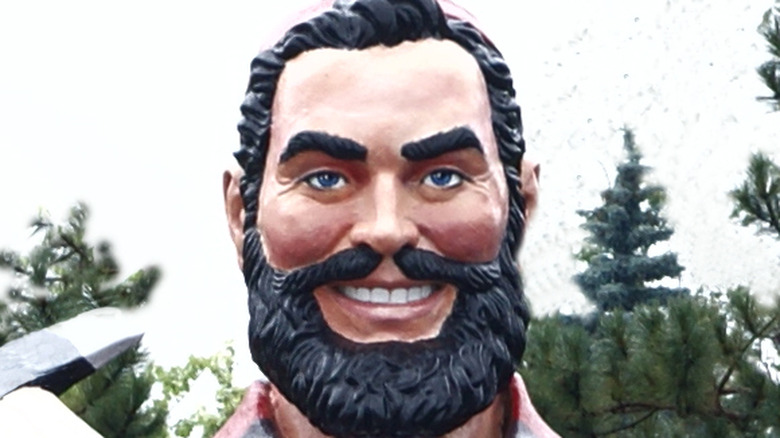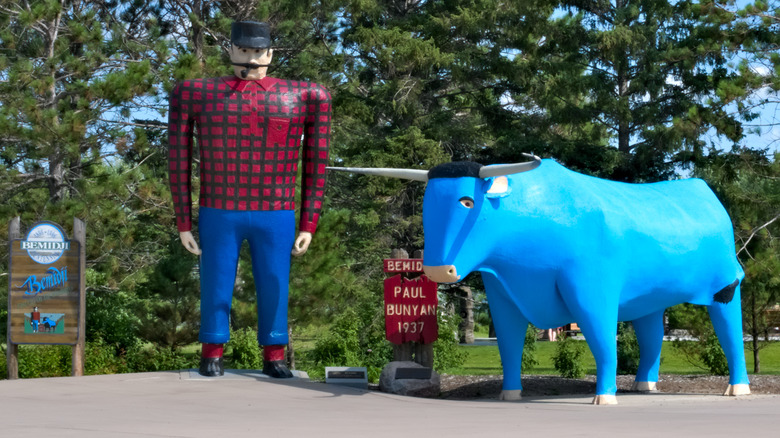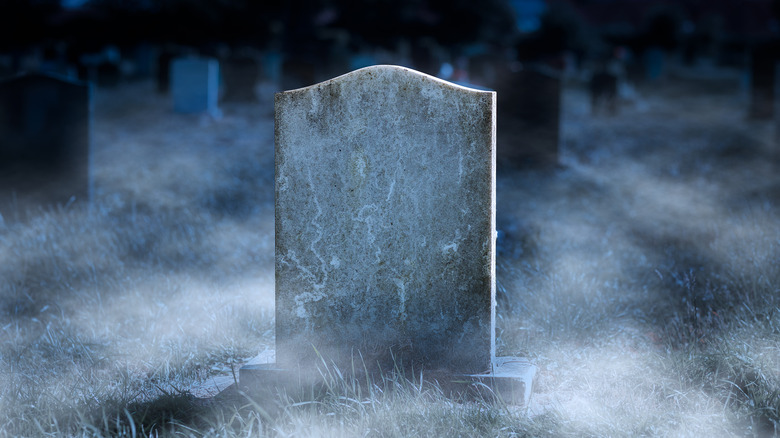The Legend Of Paul Bunyan Explained
In the plentiful forests of a young America, blue snow covered the countryside. The towering trees were swiftly cut down by a man the size of 10 grown men. His story, like his physique, was larger than life (via Britannica).
As a boy, Paul Bunyan was said to devour as many as 50 eggs for breakfast. His thirst as a baby required 10 cows' worth of milk. In fact, the only thing taller than Paul was the tale that was told of him. Paul Bunyan was a unique, exaggerated kind of legend that celebrated enormous appetites, brute strength, and speed. It romanticized the lives of all frontiersmen, filling their chests with pride and laughter.
The mere thought of a man who rolled over to create earthquakes, a man who crafted great lakes with his bare hands, was enough to make traditional frontier lifestyle endurable. It was enough to make lumberjacking seem an almost glamorous profession. This likely was the point.
Tall tales made heroes from the stories of ordinary men (via Britannica). But what made tall tales to begin with? In the case of the Paul Bunyan folklore, it was likely rooted in several exaggerated truths, many of which are surprising; some are unexpectedly gruesome.
Paul Bunyan was likely based on more than one person
It's clear that a legend as large as Paul Bunyan's would have to be rooted in some kind of truth. After all, this was the man who was said to have frozen the flames of the Upper Peninsula and tamed the waves of a whistling river that streamed liquid upward, hundreds of feet in the air (via American Folklore). Yet what really bleeds through the pages of this tale is the heart of the everyday lumberjack carving out a space for himself and his family against the backdrop of a harsh, sometimes unforgiving frontier.
Unlike Johnny Appleseed, whose status as a folk legend is based on one actual person, it would take multiple lives to inspire the story and even more mouths to tell it in order for the Paul Bunyan character we know today to prevail. In the case of this legend, many truths were fashioned together to create a quilt-like story that would be passed down through generations. History zeroes in on two fascinating individuals in the logging industry whose real lives were likely woven into this tall tale.
The first figure to fuel the Paul Bunyan story was a man called Saginaw Joe
In the French-Canadian landscape, an unexpected hero would emerge. Born Fabian Fournier, a real-life ax-wielding lumberjack with a reputation for boozing, brawling, and making mincemeat out of large chunks of wooden rails would be the first figure to inspire the Paul Bunyan story (via History).
Even this man's actual autobiography has a somewhat fantastical air to it. People believe Fabian, who later claimed the nickname Saginaw Joe, possessed two sets of teeth. Healthline reports that possessing excess teeth is rare but possible, and often related to genetic abnormalities. This phenomenon is medically referred to as hyperdontia.
Fabian Fournier was notoriously rugged and tall for his time. Born around 1845, he grew to six feet tall, towering over the average sized man of his era by approximately 12 inches (via How Stuff Works). As a point of reference, today's typical man is 5'9 (via Healthline).
Saginaw Joe was brutally murdered
The rugged Canadian lumberjack after whom the original Paul Bunyan story was modeled is said to have migrated to mid-Michigan in the United States. Here he hung out in shady saloons along the Saginaw River, which could explain how he acquired the nickname Saginaw Joe (via Sindecuse Museum).
In tavern brawls, he was particularly fond of headbutting his rivals. His head was rumored to be about as hard as a boiler plate. Still, brute strength is an ever-revolving door and in the shadows of the Red Light District it is said that Saginaw Joe encountered someone carrying an object harder than Joe's head. Saginaw Joe was discovered bludgeoned to death in Bay City's notorious Hawkins Dock in the late 1870s. His alleged killer, Blinky Robertson, roamed free.
My Bay City reports that the death of this lumberjack spawned the first of several fables starring Bunyan. This one was titled "Round River." It featured a barreling, burly outdoorsman sporting two sets of teeth who was strong enough to kill an entire herd of deer. The tale, with its vast description of fanciful feasts and exaggerated adventures, captivates campfire audiences to this day.
Saginaw Joe's skull was once on display
Adding to the mystery of this real-life story, is a rather peculiar piece of courtroom evidence: the real Paul Bunyan's skull. Sindecuse Museum reports that during the time of Blinky Robertson's trial for the gruesome bludgeoning, the skull of Fabian Fournier, a.k.a. Saginaw Joe, was included as proof. Despite Blinky's subsequent acquittal, the skull remained on display at the courthouse for quite some time. Public records speak of "its double thick bone and double rows of teeth."
As fantastical a story as that spun of lumberjack Fabian Fournier, it's possible that the Paul Bunyan legend might have ended after the "Round River" appearance. His massive skull and perplexing jawline could have easily lost their luster over the years. Alas, as time wore on, the Paul Bunyan tale grew bigger, or shall we say taller? History reports that as the legend snowballed, it picked up new life from another man.
Paul Bon Jean was probably also Paul Bunyan
It should come as no surprise that a tale this big would need multiple men serving as inspiration. It's possible that the life of revolutionary and logger Paul Bon Jean, a French Canadian (per History), fanned the flames of patriotism into the original Bunyan stories. If nothing else, this man certainly inspired the famous name of Paul Bunyan (via History). Savvy with an axe and sporting a notoriously anti-Britain political stance, Paul Bon Jean's life seems to have become infused into these fables.
How Stuff Works reports that Paul Bunyan first appeared in newspaper stories, "Logging Tall Tales," in 1910. In 1916, the Red River Lumber Company used Bunyan in a series of pamphlets to advertise their products. Later on, when the Red River Lumber Company was looking to expand its reach, the Paul Bunyan tall tales and the real people behind them were brought to the forefront of American minds (via History Collection).
Some scholars classify Bunyan tales as "fakelore" — stories "embellished by copywriters for low commercial ends," says The Straight Dope. Others claim the Bunyan stories really did originate as oral tradition entertainment in 19th century logging camps. Either way, while the day of the reigning frontiersmen has died, it is these ordinary people doing extraordinary things that make for the best campfire candor in the end.





